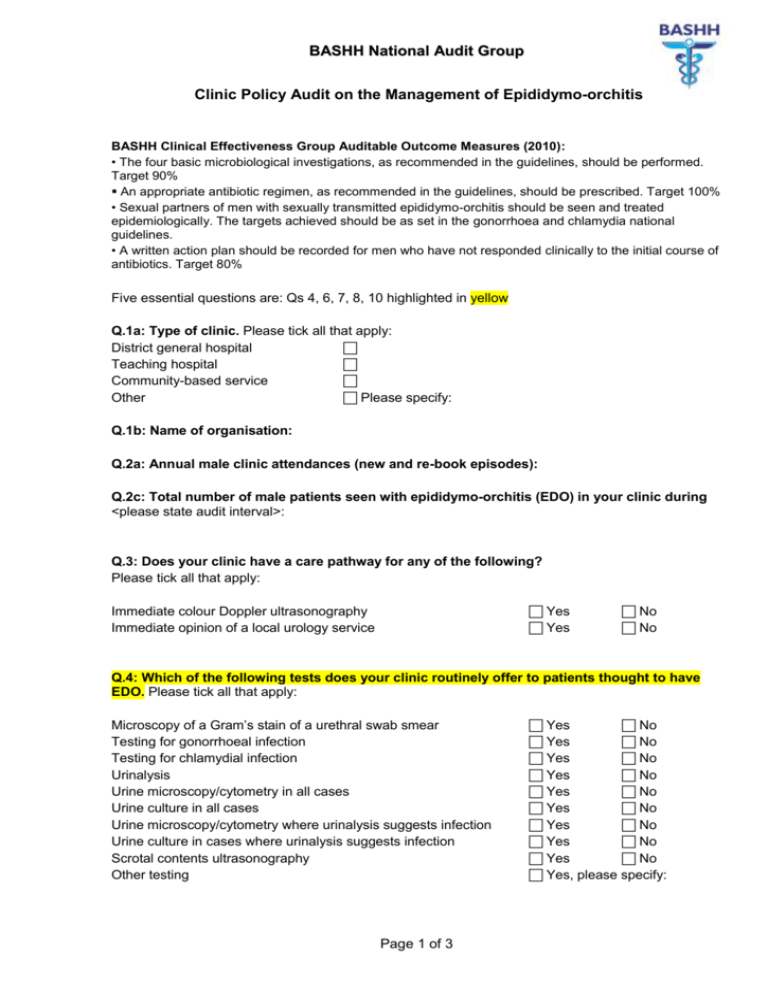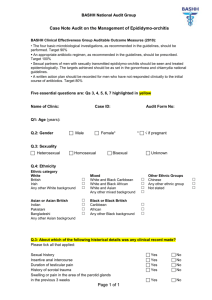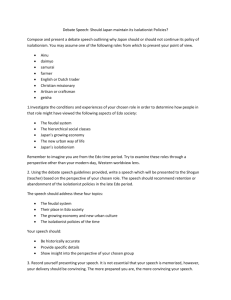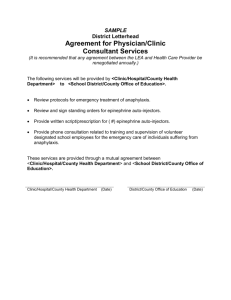
BASHH National Audit Group
Clinic Policy Audit on the Management of Epididymo-orchitis
BASHH Clinical Effectiveness Group Auditable Outcome Measures (2010):
• The four basic microbiological investigations, as recommended in the guidelines, should be performed.
Target 90%
An appropriate antibiotic regimen, as recommended in the guidelines, should be prescribed. Target 100%
• Sexual partners of men with sexually transmitted epididymo-orchitis should be seen and treated
epidemiologically. The targets achieved should be as set in the gonorrhoea and chlamydia national
guidelines.
• A written action plan should be recorded for men who have not responded clinically to the initial course of
antibiotics. Target 80%
Five essential questions are: Qs 4, 6, 7, 8, 10 highlighted in yellow
Q.1a: Type of clinic. Please tick all that apply:
District general hospital
Teaching hospital
Community-based service
Other
Please specify:
Q.1b: Name of organisation:
Q.2a: Annual male clinic attendances (new and re-book episodes):
Q.2c: Total number of male patients seen with epididymo-orchitis (EDO) in your clinic during
<please state audit interval>:
Q.3: Does your clinic have a care pathway for any of the following?
Please tick all that apply:
Yes
Yes
Immediate colour Doppler ultrasonography
Immediate opinion of a local urology service
No
No
Q.4: Which of the following tests does your clinic routinely offer to patients thought to have
EDO. Please tick all that apply:
Microscopy of a Gram’s stain of a urethral swab smear
Testing for gonorrhoeal infection
Testing for chlamydial infection
Urinalysis
Urine microscopy/cytometry in all cases
Urine culture in all cases
Urine microscopy/cytometry where urinalysis suggests infection
Urine culture in cases where urinalysis suggests infection
Scrotal contents ultrasonography
Other testing
Page 1 of 3
Yes
No
Yes
No
Yes
No
Yes
No
Yes
No
Yes
No
Yes
No
Yes
No
Yes
No
Yes, please specify:
BASHH National Audit Group
Q.5: What is your clinic policy with regards to the timing of the offer of initial antibiotic
treatment of patients thought to have EDO? Please tick all that apply:
Offered routinely to all patients before the results of
tests are available
Offered routinely to selected patients before the results of
tests are available
Offered routinely to all patients after the results of laboratory
tests are available
Other
Yes
No
Yes
No
Yes
No
Yes, please specify:
Q.6: What is the first line antibiotic treatment routinely prescribed in your clinic for
epididymo-orchitis thought to be most probably due to any sexually transmitted pathogen?
Please tick all that apply:
Ceftriaxone 250mg intramuscularly single dose, plus
doxycycline 100mg by mouth twice daily for 10-14 days
Other
Yes
No
Yes, please specify:
Q.7: What is the first line antibiotic treatment routinely prescribed in your clinic for EDO
thought to be most probably due to chlamydia or other non-gonococcal* organisms? Please
tick all that apply:
Doxycycline 100mg orally twice daily for 10-14 days
Yes
No
Ofloxacin 200mg by mouth twice daily for 14 days
Yes
No
Other
Yes, please specify:
*where gonorrhoea considered unlikely because urethral microscopy is negative for Gram negative
intracellular diplococci, and no risk factors for gonorrhoea are identified.
Q.8: What is the first line antibiotic treatment routinely prescribed in your clinic for EDO
thought to be most probably due to enteric organisms? Please tick all that apply:
Ofloxacin 200mg by mouth twice daily for 14 days
Ciprofloxacin 500mg by mouth twice daily for 10 days
Other
Yes
No
Yes
No
Yes, please specify:
Q.9: What is your clinic policy with regards to the follow up of patients with EDO?
Please tick all that apply:
No routine follow up is offered
Follow up is offered to selected patients
Yes
No
Yes, please state how this
selection is made:
Option of review left to patient choice
Three days after first seen
Two weeks after first seen
Refer to the local urology service of patients with
urinary tract infection
Page 2 of 3
Yes
Yes
Yes
No
No
No
Yes
No
BASHH National Audit Group
Yes, please specify:
Other
Q.10: What is your clinic policy for the management of men thought to have EDO who have not
clinically responded to an initial course of antibiotics? Please tick all that apply:
Yes
No
Yes
No
Yes
No
Yes
No
Yes, please specify:
Record a written action plan
Continue treatment with antibiotics
Arrange scrotal contents ultrasonography
Offer of referral to the local urology service
Other
Q.11: What your clinic policy for the management of sexual partners of men thought to have
sexually transmitted EDO? Please tick all that apply:
Offer epidemiological antibiotic treatment to sexual partners
Offer testing for chlamydial infection to sexual partners
Offer testing for gonorrhoeal infection to sexual partners
Offer a urethral or cervical swab for microscopy of a Gram’s
stain to sexual partners
Other
Yes
Yes
Yes
No
No
No
Yes
No
Yes, please specify:
*sexually transmitted EDO: EDO thought to be caused by chlamydial or gonococcal infection, or by
non-specific genital infection.
Q.12: Are patients treated for EDO routinely offered written information on EDO in your clinic?
Yes
No
Q.13a: Does your clinic have a written policy, protocol, treatment guideline, care pathway or
other document dealing with the management of EDO?
Yes
No
Q.13b: If Yes, is this based on the BASHH Guideline for the management of EDO?
Yes
No
Q.14: Please provide any additional comments about the management of EDO in your clinic:
For policy questions on partner notification, please see the Clinic Policy Audit on Partner Notification
Questionnaire: www.bashh.org/groups/national_audit_group
Last modified 20 October 2012. Hugo McClean.
Thank you for completing this questionnaire
Page 3 of 3







